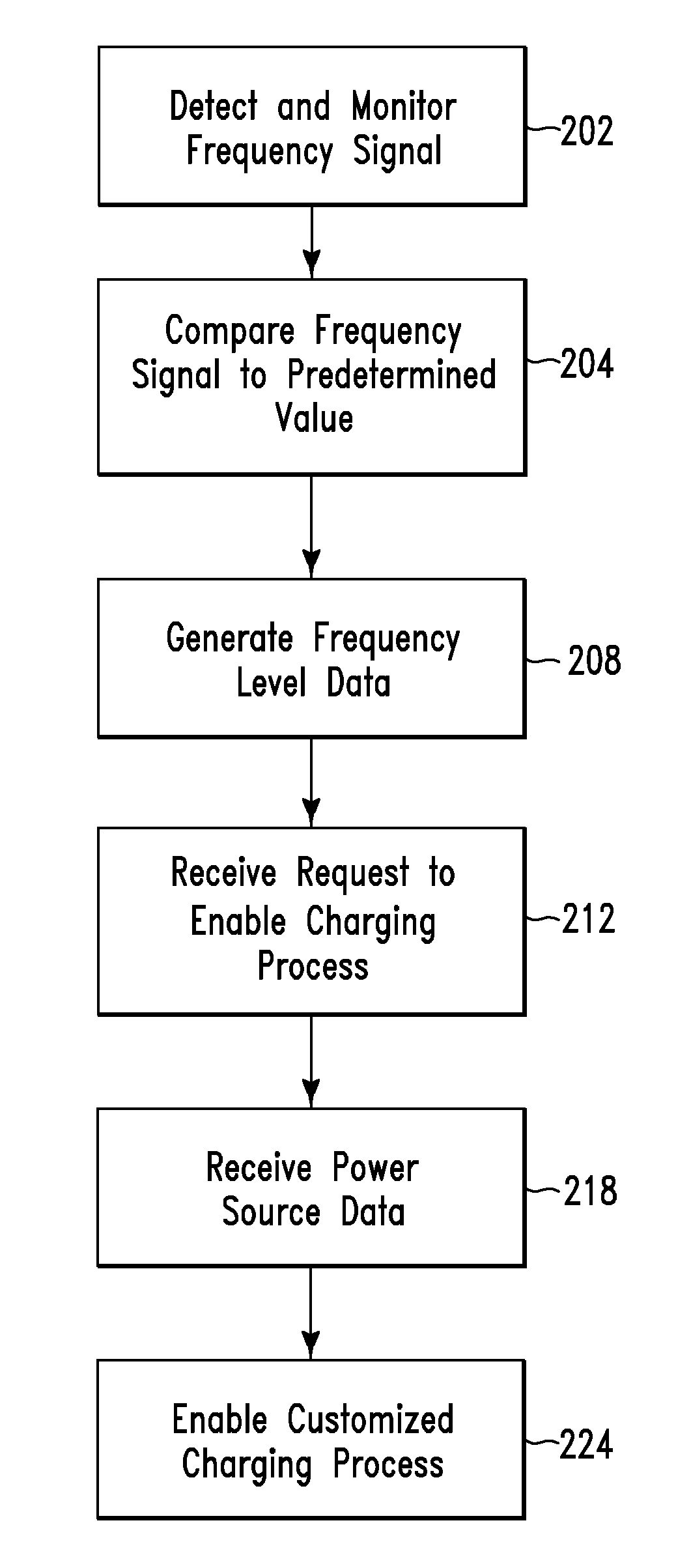Charging management method and system
a charging management and system technology, applied in the integration of power network operation systems, electric vehicle charging technology, transportation and packaging, etc., can solve the problems of limiting the flexibility to account for changes within the power system, inaccurate process for monitoring and managing various power consumption devices,
- Summary
- Abstract
- Description
- Claims
- Application Information
AI Technical Summary
Benefits of technology
Problems solved by technology
Method used
Image
Examples
example 1
[0044]Sally returns to her home late in the evening and has no future plans for that day so she parks her electric vehicle and plugs it in to the power transmission grid (e.g., via one of charging devices 11a . . . 11n or 12a . . . 12n). The CMS enables a method for charging the vehicle at variable rates based on the current frequency level of the power transmission grid. Once the electric vehicle has a full charge, the CMS enables a method for providing a trickle charge to keep the batteries topped off.
Cooperative Load-Side Charging Method
[0045]During a cooperative load-side charging method, the CMS(s) is aware of additional electric vehicles connected to the power transmission grid and attempts to distribute collective charge cycles of all the electric vehicles. For example, if 10 additional electric vehicles are connected to the power transmission grid then the CMS will determine an aggregate load to charge all 10 electric vehicles and enable charging only a percentage of the tot...
example 2
[0046]Sally returns to her home late in the evening and has no future plans for that day so she parks her electric car and plugs it in to the power transmission grid (e.g., via one of charging devices 11a . . . 11n or 12a . . . 12n). The CMS sends a connected device status to a GMS which queries a central data warehouse to determine that Sally's vehicle is a 10th electric vehicle connected to the power transmission grid. The GMS determines that it can best distribute a load by charging only 2 electric vehicles at a time. Sally's CMS then enable charging her vehicle for 20 minutes, then goes off-line for 1 hour and 20 minutes at which time her CMS begins charging her electric vehicle for another 20 minutes. This cycle continues until all 10 vehicles are charged or until new vehicles are added or removed from the power transmission grid.
Off-Peak Load-Side Charging Method
[0047]During an off-peak load-side charging method, the CMS either comprises programmed variable charge rates or que...
example 3
[0048]Sally returns to her home at 7 pm and has no future plans for that day so she parks her electric car and plugs it in to the power transmission grid (e.g., via one of charging devices 11a . . . 11n or 12a . . . 12n). The CMS queries a current rate table comprising charge rates and her calendar and determines that she will not need the vehicle until 7:30 am the following morning. Additionally, the CMS understands that the cost per kilowatt is 20% cheaper after 10:00 pm and that it is capable of fully charging the electric vehicle battery pack if it delays the start time until 10:00 pm. Sally's vehicle begins a gradual charging cycle starting at 10 pm and ramps up in energy usage by 11 pm where it is drawing a full load on that circuit for a stage 1 charge to the electric vehicle.
Known Future Events Load-Side Charging Method
[0049]During a known future events load-side charging method, the CMS has access to the electric vehicle owner's electronic calendar and may query the electro...
PUM
 Login to View More
Login to View More Abstract
Description
Claims
Application Information
 Login to View More
Login to View More - R&D
- Intellectual Property
- Life Sciences
- Materials
- Tech Scout
- Unparalleled Data Quality
- Higher Quality Content
- 60% Fewer Hallucinations
Browse by: Latest US Patents, China's latest patents, Technical Efficacy Thesaurus, Application Domain, Technology Topic, Popular Technical Reports.
© 2025 PatSnap. All rights reserved.Legal|Privacy policy|Modern Slavery Act Transparency Statement|Sitemap|About US| Contact US: help@patsnap.com



